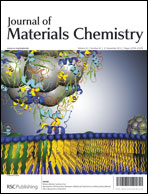Composites of chemically-reduced graphene oxide sheets and carbon nanospheres with three-dimensional network structure as anode materials for lithium ion batteries†
Abstract
It is challenging to develop lithium ion batteries (LIBs) possessing simultaneously large reversible capacity, high rate capability, and good cycling stability, which are in turn determined mainly by the component materials of batteries. We designed and synthesized a series of composites of chemically-reduced graphene oxide (CRG) sheets and carbon nanospheres (CNS). It was illustrated that within the as-obtained composites the CNSs were fully cladded and bridged with CRG sheets forming a three-dimensional (3D) network with cavities and pores. Coin cells using the anodes made of the as-obtained composites with appropriate composition exhibit large reversible capacity, high rate capability, and good cycling stability. The highest reversible specific capacity could reach up to 925 mA h g−1 and 604 mA h g−1 at charge–discharge current densities of 5 A g−1 and 10 A g−1, respectively, and faint capacity and rate capability fades were detected even after 200 charge–discharge cycles. The excellent electrochemical performance of the anodes made of the as-obtained composites in the LIBs originates from the unique 3D network structure and the intrinsic properties of CRG and CNS that provide plenty of transportation pathways for electron and Li+, and sufficient tolerant sites for Li/Li+.


 Please wait while we load your content...
Please wait while we load your content...